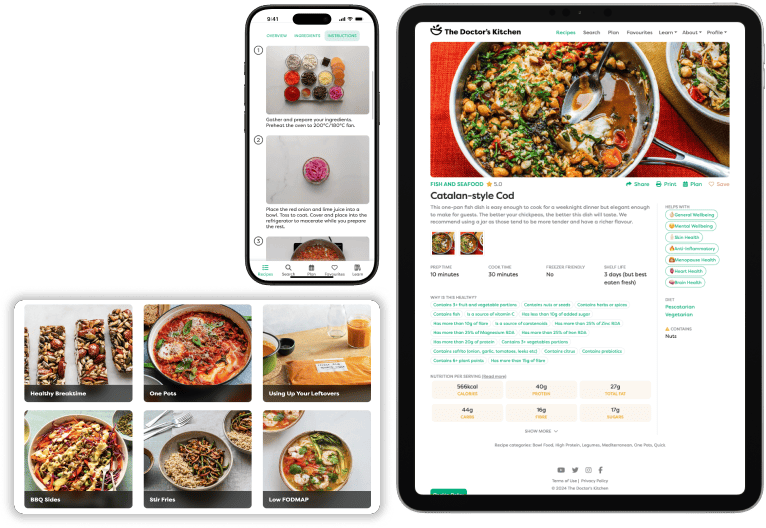Bread: How to choose quality loaves
15th Nov 2024
Quality bread made from wholegrains provides fibre, B vitamins and minerals, but poor-quality loaves often contain refined grains and additives.
Key points
Benefits of quality bread
Bread made from whole grains is a nutrient-dense food, contributing fibre, B vitamins, minerals, and polyphenols, which support:
- Gut microbiota – Fibres from whole grains can act as prebiotics, supporting gut microbes, improving gut health and the production of short-chain fatty acids.
- Better blood sugar levels – The insoluble fibre content can slow digestion and the release of glucose, possibly improving blood glucose levels.
- Disease prevention – Eating whole grains regularly is linked to a lower risk of type 2 diabetes and heart disease, likely by improving cholesterol levels and reducing inflammation.
But the amount of fibre, nutrients and the potential benefits of bread depend on how it’s made.
What makes quality bread?
Bread-making is an ancient tradition that predates agriculture, with early hunter-gatherers grinding wild grains and baking flatbreads over fire. Today, most bread is mass-produced to speed up production, leading to some key differences:
- 🌾 Whole-grain vs refined flour: Whole grains keep the entire seed, full of fibre and nutrients, but the refining process to produce white flour strips these away, leaving only the starchy core with little nutrition.
- 🥣 Minimal ingredients vs. additives: Many industrial breads use bread improvers like emulsifiers to speed up production and keep fresh longer. Some are linked to negative health effects, including disrupting the gut microbiota.
- ⏳ Speed of process: Slow dough fermentation brings out more flavour and might make minerals easier to absorb. Industrial methods skip this with quick, mechanical processes and commercial yeast, often at the expense of flavour and nutrition.
- 🔥 Baking temperature: Lower baking temperatures in homemade and artisan bread can reduce potentially harmful compounds like acrylamide, which form during high-temperature baking in industrial bread.
At its core, quality bread is all about whole grains, simple ingredients and time—bringing natural flavour and better nutrition to the table. Let’s keep it that way!
What to look for when buying bread
A darker, seeded or "multigrain" loaf isn’t always better—it’s often just clever marketing. Always check the ingredients for:
- Whole grains – Ideally, 100% whole grains like whole wheat, rye or buckwheat as the first ingredient. Some ‘whole grain’ breads have as little as 6%!
- Simple ingredients – Avoid added sugars, emulsifiers, preservatives and flavourings.
- High fibre – Aim for at least 6g of fibre per 100g.
- Diverse grains – Mix it up with grains like rye, barley, buckwheat or ancient grains like spelt for more diversity of fibres and polyphenols.
- Sourdough or long fermentation – Made with a natural starter.
- Artisan if you can – It’s usually made in smaller batches with more focus on quality. If there’s no ingredient list, don’t hesitate to ask or check their website. To find good local bakeries, you can use the Real Bread Map.
Sourdough doesn’t always mean healthier: Authentic sourdough, made with slow fermentation, might offer benefits like better mineral absorption. But it’s often used as a marketing term. Two key issues:
- Sourdough is a process, not a guarantee of quality ingredients.
- The label “sourdough” isn’t protected, so many manufacturers skip the slow fermentation that makes it beneficial.
It’s not always easy to navigate, but here’s what we focus on to help:
- Less, but better quality – Bread doesn’t need to be in every meal. Focus on having good-quality loaves but enjoy them less often.
- Add protein and fibre-rich toppings like eggs, avocado, beans, oily fish, leafy greens or unsweetened nut butter to add more nutrients keep you fuller for longer.
- Mix up your carbs – Different foods provide different types of fibres and nutrients. Some days, swap toast or a sandwich for sweet potatoes, lentils, beans or whole grains like barley and buckwheat.
Make your own
Making bread is easier than you might think, and it can quickly become a fun and rewarding weekly ritual. A few tips:
- Stock up on quality whole-grain flour like whole wheat, rye, buckwheat or spelt.
- Pick a bread day: Choose one day each week to bake your bread. It’ll become something you look forward to!
- Start with no-knead recipes: They are low-effort and perfect for beginners. Just mix the ingredients, let the dough rise overnight and bake the next day for a rustic loaf.
- Soak overnight: It might help make nutrients more accessible and create complex, rich flavours.
- Double up and freeze the dough: If you’re busy, make extra dough, let it rise overnight and freeze half for the following week.
To get you started, search ‘bread’ in our recipe bank, add it to your meal plan and we’ll generate a shopping list for you!
- Access over 800 research backed recipes
- Personalise food for your unique health needs
